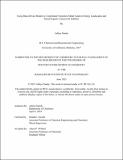Using Data-Driven Models to Understand Transition Metal Catalyst Energy Landscapes and Metal-Organic Framework Stability
Author(s)
Nandy, Aditya
DownloadThesis PDF (107.4Mb)
Advisor
Kulik, Heather J.
Terms of use
Metadata
Show full item recordAbstract
The selective partial oxidation of methane-to-methanol has been a "Holy Grail" challenge for well-over half of a century. Computational high-throughput virtual screening (HTVS) with first-principles density functional theory (DFT) can play a valuable role in unearthing design rules for scalable and viable synthetic analogues that preserve selectivity and activity observed only in enzymes. Single-site catalysts represent the most promising synthetic analogues to these enzymes, often enabling atom-economy, tunability, and selectivity not possible with bulk heterogeneous catalysts. Single-site catalysts with 3d transition-metals can access a range of spin- and oxidation-states. Due to strong oxidation and spin-state dependence on the relative energetics of reactive intermediates on the methane-to-methanol energy landscape, linear free energy relationships (LFERs) that are invoked during HTVS to simplify catalyst screening cannot be readily used. As an alternative approach, the absence of universal scaling relations between intermediate energetics provides an opportunity for non-linear machine learning (ML) models that can be used over a larger space of candidate materials. Rather than relying on linear relationships between quantities, ML models can be trained to directly predict catalyst reactivity on the basis of chemical composition and applied to thousands of compounds. In this thesis, we first study methane oxidation on transition metal complexes. We quantify the limits of LFERs that are typically used for catalyst screening. We demonstrate that LFERs systematically fail to predict individual reaction energies as well as relationships between reaction energies. We also show that there is no “one-size-fits-all” line that successfully predicts scaling behavior across distinct electron configurations. When these LFERs fail, we use ML models to harness deviations from scaling to design catalysts with increased reactivity as quantified by turnover frequencies.
Metal-organic frameworks (MOFs) are heterogeneous materials that have strong analogies to single-site transition metal complexes. For over two decades, MOFs have been developed for various applications in gas separations, sensing, and catalysis. In practice, we must activate a MOF and remove solvent from its pores to render it porous and usable. Simultaneously, the MOF must also be stable under the thermal conditions. Although the tailored metal active sites and porous architectures of MOFs are promising for separations, sensing, and catalysis applications, a lack of understanding of how to improve their stability limits their use. MOFs vary in their coordination geometries, pore sizes, coordination chemistry, metal identity, and oxidation states, which challenge the development of general structure-activity relationships that generalize over various families of MOFs. In the second part of this thesis, we harness the hybrid nature of MOFs to quantify their chemistry beyond simple pore size descriptors. We 4 adapt molecular graph-based featurizations that were successful for screening single-site transition metal complexes and generalize them to MOFs. With our new featurization, we highlight that hypothetical MOF databases are severely biased and lack metal diversity. Instead of relying on these databases to construct data-driven models, we develop workflows to mine the extant experimental literature and develop data-driven models to predict MOF stability from experimental data. Our models develop a path forward for stable MOF design. We show how we can improve the stability of existing MOFs and develop a new in silico database of “ultrastable” MOF structures.
Date issued
2023-06Department
Massachusetts Institute of Technology. Department of ChemistryPublisher
Massachusetts Institute of Technology